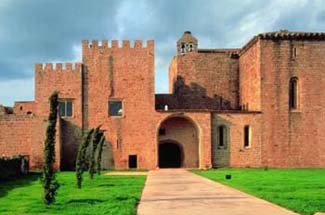
Photos courtesy of Pousada de Crato
Mosteiro da Flor da Rosa
7430-999 Crato
Tel: ++351 245 997 210
Fax: ++351 245 997 212
Official pousada website
Reserve with Booking.com
24 rooms, including 3 in tower
Double rooms: 120–228 euros
Suites: 168–313 euros
Rates include breakfast, tax,
and service.
Packages available.
Open: all year
Crato is 34 km west of Portalegre, which is near the border with Spain. The pousada is 1 km north of Crato.
On site: swimming pool
Nearby: golf; tennis; falconry
shows; horseback riding;
fishing; Alter do Chão stud
farm famed for its Lusitanian
horses.
Off the beaten track, this pousada makes an excellent base for exploring the peaceful rural countryside and medieval hilltop towns of the northern part of the Alentejo region.
Through the reception area, decorated with huge urns filled with plants upon pale stone floors, you’ll find clever ways the ancient building has been incorporated into modern uses. The former refectory, which now houses the bar, has arched windows and beautiful high vaulted ceilings supported by large, twisted stone pillars.
Furniture is contemporary but comfy. A tapestry in the dining room depicts the pine forests that once surrounded the monastery.
You’ll find the guest rooms in either the new or old wings. Rooms in the new wings are spacious, with white-washed walls, wood floors, and wicker chaise lounge chairs. Many have small balconies. Marble bathrooms are fully modernized.
The tower rooms are the largest of all and carry more of a medieval ambiance.
Outside is a pleasant walled garden with cypress and olive trees, and climbing vines.
![]() Look for the white storks nesting in the historic bell tower.
Look for the white storks nesting in the historic bell tower.